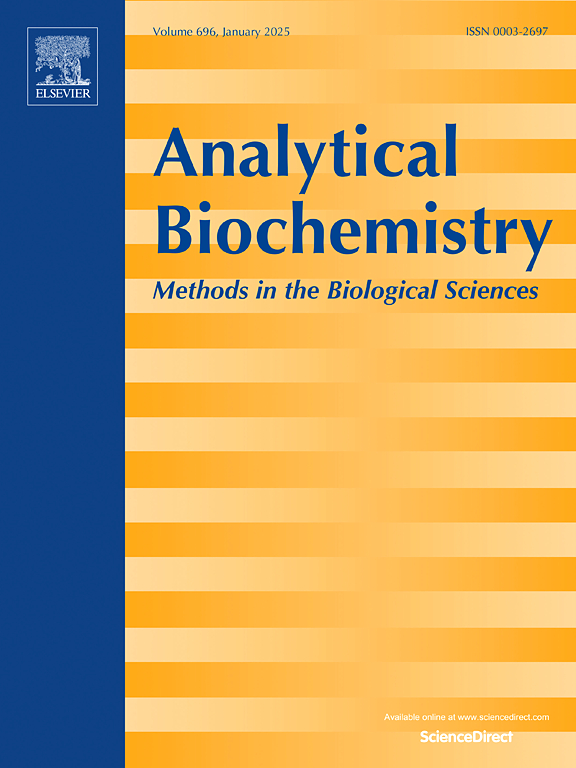微珠固定多肽的高敏感多肽阵列:在牛奶过敏分析中的应用
IF 2.5
4区 生物学
Q2 BIOCHEMICAL RESEARCH METHODS
引用次数: 0
摘要
使用含有致敏蛋白线性表位的肽微阵列进行分析有望提供有关患者临床状态的信息,但肽阵列仍然局限于研究用途。因此,我们的目标是开发一种简单而敏感的肽阵列,它可以更经济高效地进行ECL检测,从而可以在临床实践中常规使用。为此,我们开发了一种使用微珠的两步固定技术,而不是像以前的报道那样直接将肽固定在微阵列表面上。在n端生物素化的肽首先与表面带有链亲和素(sAV)的微珠结合,然后使用光反应交联剂将肽结合的微珠固定在微阵列底物上。通过这种方式,我们能够克服直接固定在增加多肽数量和接近性方面的局限性,并大大提高灵敏度,从而使ECL检测成为可能。在本研究中,我们用包含20个α s1 -酪蛋白肽的肽阵列分析了牛奶过敏(CMA)患者的血清。结果表明,患者的IgE表位模式可以单独可视化,并证实了每个患者的模式是独特的。本文章由计算机程序翻译,如有差异,请以英文原文为准。

Highly-sensitive peptide array using peptides immobilized on microbeads: Application to cow's milk allergy analysis
Analysis
with peptide microarrays containing linear epitopes of allergenic proteins is expected to provide information on the clinical status of the patient, but peptide arrays are still limited to research use. We thus aimed at developing a simple and sensitive peptide array that operates with more cost-effective ECL detection, so that it can be routinely used in clinical practice.
For this purpose, instead of directly immobilizing the peptides onto the microarray surface as in the previous reports, we developed a two-step immobilization technique using microbeads. Peptides biotinylated at the N-terminal are first bound to microbeads with streptavidin (sAV) on the surface, followed by immobilization of the peptide-bound beads onto the microarray substrate using the photoreactive crosslinker. In this way, we were able to overcome the limitations of direct immobilization in increasing the amount and accessibility of peptides and greatly enhance the sensitivity so that ECL detection became possible. In the present study, we analyzed sera from cow's milk allergy (CMA) patients with our peptide array containing 20 peptides from αS1-casein. The results showed that IgE epitope patterns of patients could be visualized individually, and confirmed that the pattern is unique to each patient.
求助全文
通过发布文献求助,成功后即可免费获取论文全文。
去求助
来源期刊

Analytical biochemistry
生物-分析化学
CiteScore
5.70
自引率
0.00%
发文量
283
审稿时长
44 days
期刊介绍:
The journal''s title Analytical Biochemistry: Methods in the Biological Sciences declares its broad scope: methods for the basic biological sciences that include biochemistry, molecular genetics, cell biology, proteomics, immunology, bioinformatics and wherever the frontiers of research take the field.
The emphasis is on methods from the strictly analytical to the more preparative that would include novel approaches to protein purification as well as improvements in cell and organ culture. The actual techniques are equally inclusive ranging from aptamers to zymology.
The journal has been particularly active in:
-Analytical techniques for biological molecules-
Aptamer selection and utilization-
Biosensors-
Chromatography-
Cloning, sequencing and mutagenesis-
Electrochemical methods-
Electrophoresis-
Enzyme characterization methods-
Immunological approaches-
Mass spectrometry of proteins and nucleic acids-
Metabolomics-
Nano level techniques-
Optical spectroscopy in all its forms.
The journal is reluctant to include most drug and strictly clinical studies as there are more suitable publication platforms for these types of papers.
 求助内容:
求助内容: 应助结果提醒方式:
应助结果提醒方式:


